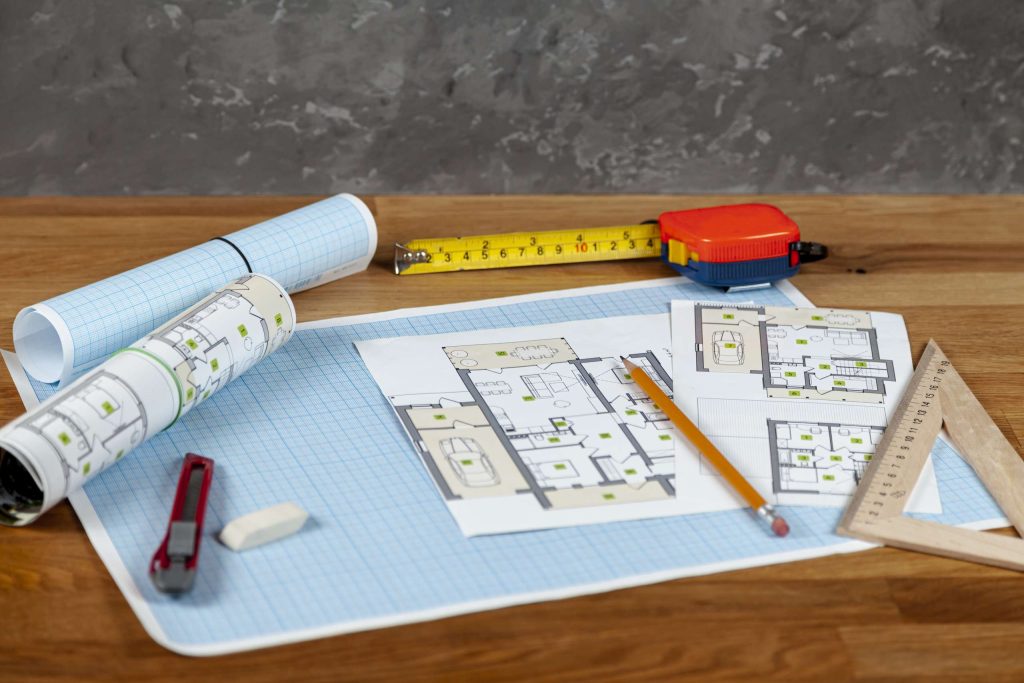The 9 Best Flooring Options for Your Home
The choice of flooring is one of the most important decisions you must make when putting the foundation in place for the home of your dreams. It can be an exciting experience to decide from among the numerous options presented to you, each of which possesses its unique allure and merits consideration. Let’s start this journey by looking into the best flooring options offered by flooring cost estimators that are adaptable to various lifestyles, budgets, and requirements for the available space.
Here are 9 types of flooring that are the best of the best in terms of quality and style. From hardwood’s timeless elegance to engineered wood’s affordable sophistication, these options will last and look great.
The Timeless Elegance of Hardwood
Hardwood has always been and will continue to be the material of choice for wood floor cost estimators. Its enduring appeal, a testament to its unparalleled beauty and longevity, lends a touch of classic elegance to the environments in which it is displayed. This luxury, however, comes at a cost and necessitates a more significant financial investment.
Engineered Marvels: Wood’s Affordable Sibling
Installing engineered wood flooring, similar to its counterpart made of hardwood, will lend an air of refined sophistication to the area you’re working with. It is an option that is easier on the wallet and can gracefully withstand the test of time, oblivious to the allure of warping and cracking when subjected to the caprice of moisture.
Tiles: Crafting Mosaics of Versatility
Tiles, known as the chameleons of the flooring world, provide an almost unfathomably wide range of design options. Drawing inspiration from diverse materials, colors, and patterns, they can work their design magic in spaces such as kitchens, bathrooms, and mudrooms. This gives the impression that the area can adapt to different uses and is resilient overall.
Laminate: The Thrifty Illusionist
Laminate flooring enters the stage like a skilled illusionist imitating hardwood’s grandeur or tiles’ panache. Laminate flooring can be purchased in plank or tile formats. Although it is accessible on the wallet and quick to set up, it does not possess the same unyielding fortitude as its more expensive competitors.
Vinyl: Versatility Meets Affordability
Vinyl, the unheralded hero, is emerging as an inexpensive and durable competitor. This is a significant development. When you decorate your space with a kaleidoscope of colors and patterns, you accept the invitation to simple installation and maintenance that you have extended to yourself. In addition, because of its water resistance, it is highly prized as a possession in conditions where there is a lot of moisture.
Linoleum: Nature’s Refined Grace
Linoleum, a tribute to nature’s finesse, graces your floors with sustainable splendor. Its durability, water resistance, and easy upkeep paint a portrait of refined elegance. Yet, be prepared for a slightly heftier investment.
Bamboo: Nature’s Resilient Symphony
Bamboo, the verdant warrior, strides forth as a sustainable paragon of strength. With an innate resistance to water and allergens, it emerges as a boon for those with sensitivities. Its ease of maintenance and cleaning adds another feather to its cap.
Concrete: The Stoic Artisan
Concrete, the stoic artisan, emerges as a canvas for creativity. Stain, polish, or paint it—the choice is yours. Durable, stylish, and easy to care for, it lends an industrial chic vibe to your space.
Brick: Rustic Charm Meets Reliability
Brick, steeped in rustic charm, graces kitchens, bathrooms, and mudrooms with its enduring allure. Easy to clean and maintain, a protective seal can shield it from the clutches of stains.
Additional Flooring Options
Beyond the classics, a wave of newcomers seeks their place in the limelight:
- SPC Vinyl Flooring: This rigid core vinyl flooring, staunch in its durability and water resistance, presents itself as a stalwart contender. Easy installation and low maintenance sweeten the deal.
- Luxury Vinyl Tile (LVT): A virtuoso mimic, LVT replicates the essence of natural elements like wood and stone. Durable, water-resistant, and a breeze to install and maintain, it ushers in a touch of luxury.
- Cork Flooring: This sustainable marvel invites comfort with its soft, yielding embrace underfoot. It champions health and sustainability and is naturally hypoallergenic and resilient against mold and mildew.
The Tapestry of Choice: Weaving Budget, Lifestyle, and Aesthetics
As you stand at the threshold of flooring decisions, flooring takeoff services let your budget, lifestyle, and each room’s unique needs guide your steps. Let the overarching aesthetic of your abode be the North Star, heading you toward a flooring choice that harmonizes with your décor. In this symphony of options, your home’s foundation will resonate with style and functionality, a testament to your discerning taste.
Revolutionize Your Renovation Journey with Remote Estimation
Revolutionize your renovation journey with our cutting-edge Remote Estimation service. Say goodbye to lengthy on-site visits and hello to swift, accurate assessments delivered straight to your device. With the best flooring cost estimator, you’ll have the power to plan your home improvement projects with precision and efficiency. Whether you’re a homeowner or a contractor, our seamless solutions cater to your specific needs. Experience the future of effortless budgeting and elevate your renovation experience today. Take advantage of this opportunity to streamline your projects and unlock a new level of convenience. Try Remote Estimation now and witness the transformation firsthand!
Importance Of Drywall Professionals In Construction Projects


While drywall specialists play a vital role in shaping our buildings’ interior spaces, their contribution often remains unsung and unacknowledging by those outside their field of construction work. While most drywall cost estimator in this profession remain unknown, their contributions are integral in crafting that framework – from seamlessly installing and finishing drywall installations to shaping structural integrity and aesthetic appeal of construction projects. Let us investigate their role in shaping the structural integrity and aesthetic appeal of construction projects.
Craftsmanship of Drywall Professionals
Drywall professionals are:
Drywall estimating services in construction are master artisans, honing their craft over years of practice and dedication. Careful planning ensures each installation goes off without a hitch – guaranteed flawless execution of each installation for seamless performance that aligns precisely with intended designs. Their passion for perfection creates the basis of structurally sound yet visually appealing interior spaces.
Efficiency: Time and Cost Savings
Drywall experts who can efficiently accelerate installation and finishing processes are invaluable resources in any construction team. The drywall cost estimator skills not only shorten timelines but also save considerable costs due to employing cutting-edge installation techniques – optimizing both time and resources efficiently with this art form; their mastery speaks of their contribution towards practical building projects overall and reinforces their presence as integral members who deliver enhanced productivity that drives positive project outcomes and development initiatives forward.
Priority Safety Is No Subtractable Issue
Safety on any job site is paramount, and drywall professionals possess extensive knowledge regarding safe installation and finishing practices that ensure worker safety. Their knowledge provides a more secure working environment by decreasing risks related to accidents or injuries at job sites.
Valuable Expertise: Beyond Installation
Professional drywall estimating services serve as valuable advisors when selecting materials for every project and are adept at overcoming obstacles and troubleshooting challenges that may arise during execution. With experienced hands and sound advice, they ensure a seamless process from start to finish, ultimately elevating its outcome.
Drywall Cost Estimators
A reliable drywall cost estimator is invaluable to homeowners and contractors. By taking into account project size, type, local material costs and labour expenses as well as labour expenses incurred on site, this tool serves as a practical budgeting resource – but bear in mind that while estimators provide great insights, their final costs could still change due to unanticipated factors.
Precision of Drywall Takeoffs
Professional drywall takeoffs are conducted by experienced specialists using careful measurements and calculations to ascertain the amount of drywall necessary for any project. Drywall takeoffs are essential to ensure that a project will be successfully finished, so this step in the process should not be skipped. Estimators ensure the most efficient use of available resources by providing estimates that are as precise as possible, thus eliminating unnecessary costs or delays caused by lack of availability that might otherwise arise due to a shortage. They ensure this by accurately calculating estimates that provide the most optimal use of available resources – this ensures no unnecessary costs or delays caused by lack of availability will arise, including any costs or delays that a shortage might otherwise incur.
Utilizing Drywall Estimating Services Experience
Utilizing drywall estimating services offers homeowners and contractors an additional layer of accuracy and professionalism with comprehensive packages that include takeoffs, cost estimates, project timelines and project takeoffs – giving everyone peace of mind that their projects will likely stay on budget and schedule.
Drywall takeoffs involve quantifying the materials and labour required for a project, which can be intricate and time-consuming, especially with larger or more complicated endeavours. Wall estimating services possess the experience to accurately and efficiently complete takeoffs while considering all costs. Once complete, an estimator will create a comprehensive cost estimate, including materials, labour costs, equipment expenses, overhead expenses, and any relevant market factors or other relevant expenses, to ensure their estimates are as precise as possible.
Drywall professionals are unsung heroes of construction. Their skills go far beyond mere installation; instead, theirs is an art that marries precision with efficiency and safety to produce flawless installations. When embarking upon your construction journey, remember drywall estimating services play an invaluable role in shaping spaces to inspire us all and creating environments we call home for years.
Drywall Estimating Made Easy: Remote Estimation
Remote estimation has revolutionized how we approach drywall projects, providing a smooth, time-efficient, and precise method for gathering professional estimates. It gives homeowners and contractors an innovative solution to estimate drywall takeoff/drywall projects cost-effectively and with greater convenience – especially for those living in remote areas or having busy schedules. Furthermore, remote estimates boast significant speed advantages over traditional methods; estimators can avoid time-consuming on-site visits and measurement processes altogether.
We provide estimates as accurate as conventional approaches due to sophisticated software considering factors like project size, type, location, and chosen materials. Remote Estimation offers the ideal way for anyone involved with drywall work to secure professional drywall estimating service while streamlining the process and cutting associated costs and inconveniences.
Crucial Construction Estimating Mistakes to Avoid


Estimating a project is challenging, especially in construction, where the professionals have to consider unforeseen details of material required, takeoffs, and negligence in accounting; this can lead to significant losses in estimation. Construction cost estimators must have a clear understanding of the project scope and accurate takeoffs to avoid mistakes that can be expensive. Failing to utilize the proper construction methods can delay the project and cost more than required. This article will discuss the crucial errors you can avoid using construction estimating services, saving time and resources.
Common Estimating Mistakes
Here are some of the few mistakes that seem common but have a significant impact on the project’s progression:
Inaccurate takeoffs
Estimating construction takeoffs is evaluating the material required for the project, which helps estimate the cost. Only accurate takeoff estimates can lead to sufficient material availability and project delays, costing time and financial resources. Construction cost estimators evaluate the project’s material requirement based on the project’s scope and dimensions, which helps them to analyze the material and equipment required.
Labour costs
Labour costs can be very challenging to estimate, as construction workers play a major role in any construction project. While evaluating the labour cost, several factors need to be considered by construction cost estimators, including the availability of the workers for the project to their level of experience, rate of their pay, and productivity, as an experienced worker can charge higher as he can work efficiently, accomplishing his target in less time, compared to someone less experienced. Focusing your cost estimation of labour cost can determine the number of man-hours required to complete the task, which will also help estimate the time it will take for the project to complete.
Materials and supplies costs
The construction materials and supplies cost can change occasionally depending on the market’s condition. It is important to stay updated with the current market conditions, as it’ll help you accurately estimate the cost of various materials and the charges for the material transportation at the construction site. Some construction estimating services work closely with suppliers to help their clients provide them with the best deal possible and a wide range of construction materials, transportation, etc.
Failing to assess risks and contingencies
Construction projects almost always involve risks, whether unexpected site conditions, unfavorable weather, or time delays. When estimating, it is vital to consider various factors that can delay the estimated timeline, as there could be reasons such as delay in the material supply, transportation issues, unavailability of the required material, or even a shortage of workers. If a construction cost estimator does not consider this, the client may face serious damages in terms of finances and resources.
Not conducting a site visit
Not conducting a site visit before construction can lead to several consequences, such as insufficient knowledge about the site’s specific characteristics, such as soil, nearby structures, and access points. This lack of effort can also increase the risk, such as unstable ground, resulting in serious construction problems. A site visit will enable the team to properly analyze the area for evaluating the project’s design, requirements, and access points for transporting material and equipment.
Overlooking costs
When estimating the construction cost, various hidden costs are associated with the project. This may include permits, insurance, waste disposal, etc. There is always a need for the transportation of materials near the construction; for that, the construction company must have a proper permit to move equipment and materials from time to time. Construction cost estimators consider permit charges, insurance, and waste disposal to avoid financial surprises.
Lack of a thorough audit of estimates
When the construction cost estimation process is completed, there’s always some human error in calculation or even missing some important factors. Professionals of construction estimating services ensure to thoroughly audit the estimation details to identify any miscalculation that can lead to serious consequences.
Importance of Accurate Estimates
Accurate estimates are crucial in construction projects as they help the team make informed decisions by allocating resources effectively and managing project timelines. Inaccurate estimates can lead to cost overruns, delays, and scope, causing project success to be compromised. You can simplify this process by consulting with a construction estimating service with reliable data, considering potential risks and contingencies, and regularly updating you as the project progresses.
Remote Estimation: Your Dedicated Construction Estimator USA
As a leading construction estimating company in the USA, Remote Estimation offers a wide range of services to help contractors and project managers estimate and complete their projects on time and on budget. Our professional team has years of experience in the construction industry and is equipped with the latest technology, ensuring our clients get a reliable and accurate estimating solution from us.
If you are searching for a dedicated team to help you with your construction project estimation, we are your perfect partner. Contact us today or visit our website to learn more about our services.
Why Accurate Construction Takeoff Services Are Important


Accurate takeoff services form the cornerstone of every successful construction project, setting accurate cost estimation and resource allocation into motion. Every nail, brick, and beam in construction holds economic value – by conducting thorough takeoff services, we ensure details are noticed and reduce the margin for error in budgeting and planning processes, streamlining operations further while increasing overall project efficiency. This article explores why construction takeoff services are integral to this sector’s excellence-seeking.
Role of Takeoff Service in Construction Projects
Construction takeoff services utilize various methods to estimate material and input quantities needed in bidding, estimating, and buying processes. Takeoffs help contractors determine precisely the amount of materials they will require based on precise measurements, values, checklists, plans, cost prediction software tools such as bid optimization or cost prediction models to generate accurate takeoff estimates that provide clients and contractors with accurate material cost projections or bid optimization analysis results; accurate takeoff estimates allow clients and contractors to meet delivery timetables more easily while design errors may create inaccurate estimates due to starting with design documents as the starting point for project cost prediction or bid optimization processes.
The Value of Accurate Construction Takeoff Services
Quantity takeoff services are essential to the success of any construction project, helping estimate materials and labor needs to be completed on schedule and with maximum savings in costs and increased safety. Here, we will explore their many benefits, including savings on materials/labor costs, improved project management/administration capabilities, and time saved when taking off projects accurately.
Savings on expenses
Regarding businesses in the construction industry, one of the most significant advantages of accurate takeoff services is the possibility of cost savings on purchasing material. These cost savings are accomplished by cutting down or eliminating the expenses associated with overbuying and wasteful purchasing practices. With the assistance of accurate quantity takeoff services, construction companies can avoid unnecessary overspending on the materials necessary for their projects and instead order only what is genuinely required.
Improved Project management
Utilizing construction estimating services NYC has numerous advantages regarding project management, with accurate takeoffs assisting project managers in better budgeting and scheduling their projects, leading to fewer delays or reworks and increased efficiency due to cost savings.
Accident Prevention
Error-free and accurate construction takeoff can significantly improve site safety, with construction companies making sure all necessary safety equipment is available with more accurate materials lists. Furthermore, accurate takeoffs help identify potential risks that might help avoid accidents.
Precision in construction takeoff services is essential to the success of any building project, helping ensure its completion on schedule, within budget, and safely. Construction firms rely on accurate takeoff to complete projects successfully.
The Various Types of Construction Takeoff Services
Takeoff services are essential components of construction industry processes because they allow firms and projects to measure and quantify materials and labor required for projects. Two categories of construction takeoff services are used by construction firms – manual takeoff and digital. Manual services utilize physical tools, while digital takeoff utilizes specialized software; project requirements determine which service to utilize.
The Various Types of Takeoff Services:
Manual takeoff: This service entails measuring and quantifying the materials and labor needed for a construction project using physical tools such as rulers, calculators, and blueprints. This method takes time and is prone to human error.
Digital takeoff: This type of takeoff service involves measuring and quantifying the materials and labor needed for a construction project using specialized software. This method is more accurate, faster, and less prone to error.
Manual takeoff services are less efficient and more prone to errors when compared to digital takeoff services. At the same time, digital takeoff services are more accurate, faster, and less prone to errors. In the long run, digital takeoff services are more efficient and cost-effective. However, some companies and contractors continue using manual takeoff services for various reasons, including more access to technology or specific project requirements.
To summarize, both manual and digital takeoff services have benefits and drawbacks. Manual takeoff services may be more familiar and comfortable for some people. Digital takeoff services are more efficient and precise. Companies and contractors must consider their project requirements before deciding on the best takeoff method.
Get Accurate Takeoffs On Time and Budget with Remote Estimation
Remote Estimation offers accurate takeoff services to ensure projects run efficiently, including manual takeoffs, digital takeoffs, bid takeoffs, material takeoffs, and labor takeoffs. Furthermore, our tailored takeoff solutions can meet specific project needs.
Our experienced takeoff professionals use cutting-edge software and technologies to rapidly and precisely estimate materials and labor requirements for your project and deliver reliable yet cost-effective takeoff services on schedule and budget. Reach out to Remote Estimation now to discover more of our services and see how they can assist with starting your project on an ideal course.
6 Concrete Take-off Tips for Estimators & Contractors


Imagine a world where buildings are put up quickly, well, and within a set price—where construction projects are finished on time and with no surprises. The art and science of construction cost estimation make this world possible. A concrete take-off estimate is figuring out how much a building project will cost. This helps make sure the project is cheap and can be done. It takes a mix of information, experience, and good judgment. This article is about six concrete take-off tips that any estimator or contractor must know to avoid expensive surprises and ensure their job is finished on time.
Six Essential Secrets for Precision Estimation
Here are the six essential keys to unlocking the realm of precise commercial/home construction estimating. Like old alchemists, modern estimators can transform blueprints into tangible reality. Each key promises to turn mere plans into thriving structures, ensuring projects stay on course, on budget, and on schedule. Let’s embark on this journey of discovery, where precision meets imagination and foresight melds with expertise. These six secrets will guide you through the labyrinth of estimation, lighting the way to success in the construction world.
Blueprint Mastery
Before the first shovel hits the ground, it’s crucial to delve deep into the blueprint. This is where the foundation of your estimate lies. Familiarize yourself with every nook and cranny of the plans, from the architectural drawings to the structural details. Take note of any peculiarities or complexities affecting costs, like irregular shapes or non-standard materials. This intimate understanding will serve as your compass throughout the estimation process.
Quantity Breakdown
A meticulous quantity survey is the cornerstone of any accurate construction cost estimation. This step involves dissecting the project’s elemental components and quantifying every material, labor, and equipment requirement. It’s not just about counting bricks and beams; it’s about discerning the nuances that differentiate one task from another. Leverage technology, like advanced construction take-off services, to expedite this process and minimize human error. Remember, precision here leads to accuracy in your final estimate.
Contingency Planning
In the unpredictable realm of construction, surprises are part of the course. That’s why building a safety net into your estimate is imperative. Contingency factors, such as unforeseen site conditions or market fluctuations, should be clearly defined and accounted for. A prudent estimator allocates a percentage of the total estimate to cover these unforeseen circumstances. This ensures that when the unexpected occurs, your project will be supported by budgetary constraints.
Market Insight
The construction industry is a dynamic ecosystem influenced by various external factors. Stay abreast of market trends, material prices, and labor costs. Periodically update your knowledge to reflect the current home construction estimating and economic climate. This foresight empowers you to make informed decisions during the estimation process. Utilize industry publications, engage with suppliers, and tap into professional networks to gather the latest intel. Remember, knowledge is your most potent tool in navigating cost fluctuations.
Collaborative Estimation
Construction is a collaborative effort, and estimators are an integral part of the team. Engage with architects, engineers, and subcontractors early in the process. Their expertise can offer invaluable insights into potential cost-saving measures or alternative materials. Foster open lines of communication to ensure everyone is aligned with the project’s objectives. This collaborative approach not only refines your estimate but also strengthens the foundation of a successful construction venture.
Estimate Refinement
An estimate is not set in stone; it’s a dynamic document that evolves with the project. Continuously refine your construction cost estimation as new information to validate your assumptions and calculations with real-world data and on-site assessments. Leverage feedback from past projects to fine-tune your estimating process. Remember, the mark of a seasoned estimator is the ability to adapt and refine their approach based on experience and evolving project dynamics.
In construction, precision and foresight are the linchpins of success. By mastering the blueprint, conducting a thorough quantity survey, accounting for contingencies, staying market-savvy, fostering collaboration, and embracing iteration, estimators, and contractors with professional construction take-off services can confidently navigate the complex terrain of cost estimation. These six concrete take-off tips are the keystones to ensuring your projects are completed on time and within budget. So, go forth and build with the knowledge that your estimates are as solid as the structures they represent.
Remote Estimation Redefined: Elevate Your Construction Game
Ready to revolutionize your construction cost estimation process? Join us in embracing the future with our cutting-edge Remote Estimation services. Say goodbye to traditional limitations and hello to accurate, speedy, and convenient estimations. Our expert team utilizes advanced technology to streamline your projects, ensuring every estimate is precise and on point. Distance is no longer a barrier – with Remote Estimation, we bring efficiency to your fingertips. Elevate your construction skills and enjoy a seamless and hassle-free construction cost estimation process. Contact us today and take the first step toward a more efficient and cost-effective construction process.
How to Become a Successful Commercial Construction Estimator in New York


Becoming a construction estimator in New York requires comprehensive knowledge, field experience, and professional skills. With the city’s construction projects, the demand for estimators is on the rise. In this article, we’ll walk you through the steps to becoming a construction estimator in NYC. We’ll discuss the roles and responsibilities of a construction estimator, provide insights into their qualifications and education, and offer tips on excelling in this field. Whether you’re a graduate starting your career or an experienced professional looking to transition into construction, this article will provide information to help you achieve your goals. Discover the path to success as a commercial construction estimator in the vibrant city of New York.
What are the Important Roles of Construction Estimation Services in NYC
Ensuring Site’s Regulatory Compliance
Building projects in New York City must follow strict rules and codes for buildings. Construction estimating services in New York City know all about these rules. In this way, they ensure that project estimates are legal, preventing delays and fines from being too expensive.
Improving Budget Allocation
Construction Cost Estimating Services NYC helps people involved in a project better manage their budgets. This keeps costs from going over budget and ensures enough funds for every step of the building process, from planning before construction to inspecting afterward.
Optimizing Project Planning
The lumber take-off services give accurate estimates of how much things will cost. That’s how they help project managers make complete plans for their projects. These plans include schedules, how to use resources, and ways to handle risks. This allows projects to get done quickly and well.
Ensuring Informed Decision-Making
Construction companies can make intelligent decisions throughout a project’s lifecycle with accurate estimates. From choosing the least expensive building materials to figuring out the best way to build something, making decisions based on data leads to successful projects.
Improving Competitiveness
When construction companies are bidding, having accurate estimates gives them an edge. Accurate estimates also give clients confidence and raise the chances of winning projects.
Reducing the Chances of Project Delays
Estimating services for construction costs helps find problems and challenges early on. As a result, it lets proactive steps be taken to reduce delays. In New York City, where time is of the essence, projects must be finished on time.
Facilitating Collaboration
Construction Estimator NYC ensures coordination between architects, engineers, contractors, and clients interacting and exchanging information with each other. Working together speeds up the progress of the project. So, they make it possible for everyone to work together without problems.
Qualifications Required to Become a Construction Estimator in NYC
To become a Construction Estimator in New York City, some qualifications are required:
Education: Obtaining a bachelor’s degree in Construction Management, Civil Engineering, or a related field is essential. This educational background can provide a foundation for a career as a Construction Estimator.
Field Experience: Gaining experience through entry-level positions in construction estimating or similar roles is valuable. This allows you to develop hands-on knowledge and gain insights into the industry.
Specialize: Choosing an area of specialization within the construction field, such as commercial or industrial construction, can enhance your expertise and make you more marketable as a Construction Estimator.
Analytical and Mathematical Skills: Proficiency in analyzing project plans, conducting cost calculations, and utilizing formulas is crucial for successful construction estimating.
Obtain Certification: You can obtain certification in Construction Estimating from organizations like the American Society of Professional Estimators (ASPE). Their comprehensive training programs cover plan reading skills, estimating math techniques, and bidding fundamentals.
Mastering the Techniques of Construction Estimation
Construction estimation services can master the technique of various estimations by following these key points:
- Understand the project scope: Gain a thorough understanding of the project requirements and specifications to estimate the costs involved accurately.
- Gather relevant data: Collect data from reliable sources, such as past projects, industry standards, and expert opinions, to ensure accurate estimations.
- Utilize different estimation techniques: Employ a combination of top-down and bottom-up estimation techniques to provide a comprehensive and detailed cost breakdown.
- Use appropriate software: Leverage construction estimation software to streamline the estimation process, improve accuracy, and track costs effectively.
- Continuously update knowledge: Stay updated with industry trends, materials costs, and labor rates to ensure estimations reflect current market conditions.
- Regularly review the estimates: Review and refine the calculations based on actual project costs, customer feedback, and lessons learned from mistakes to enhance future estimations.
By following these practices, construction estimation services can master the technique of various estimations and provide accurate cost estimates for successful projects.
Compliance and Regulations for Estimators in New York
Complying with regulations is vital in the construction industry to ensure the proper implementation of projects. Estimators play a role by understanding and adhering to the relevant compliance and regulations specific to their areas.
- Obtain coverage for stormwater discharges
- Review and approve Stormwater Pollution Prevention Plans (SWPPPs)
- Maintain an inventory of active construction sites
- Conduct site inspections and enforce erosion and sediment control measures
- Maintain an inventory of post-construction Stormwater Management Practices (SMPs)
- Inspect and implement long-term maintenance of SMPs
- Train staff in SWPPP reviews and site inspections
- Ensure training of construction managers and site operators
- Educate stakeholders about the Construction and Post-Construction (C/PC) Program
- Comply with regulations and adhere to the regulatory requirements of the C/PC Program
By knowing these regulations, estimators contribute significantly to the compliant completion of projects, prioritizing the safety of workers, protection of the environment, and public welfare. Adhering to regulations not only safeguards the reputation of construction companies but also enhances overall efficiency and effectiveness throughout the construction process in New York City.
Streamline Your Construction Projects with Remote Estimation
Are you in search of a hassle-free way to estimate your construction projects? Look no further! Introducing Remote Estimation, a solution that enables you to obtain cost estimates without the need to leave your office. Our team of construction estimators in NYC guarantees project estimation is delivered to you promptly. By leveraging our service, you can save time, reduce expenses, and streamline your construction process. Reach out to us today for a consultation.
5 Reasons to Use a Construction Estimating Service – Remote Estimation


Reliable cost estimates for construction projects are significant for industrial and residential projects. This is where construction cost estimating companies come in. Using these services, stakeholders can benefit from a framework that evaluates aspects of a project, providing them with essential data to make well-informed decisions. Construction estimating services help eliminate expenses and increase the number of projects that can be secured, enhance profit margins, and save valuable time. This article highlights five compelling reasons to consider such a service.
Reason 1: Optimizing Budget & Avoiding Cost Overruns
Construction estimation services play a role in optimizing budgets and preventing costs. These services are essential for project stakeholders to make decisions and allocate resources effectively. They help identify opportunities to reduce material waste, minimize labor expenses, and negotiate prices by providing cost estimates. Additionally, these services assist in creating budgets and optimizing project plans, ensuring that projects remain within budget constraints. Through their contribution to avoiding delays and implementing schedules, construction cost estimating companies facilitate the smooth execution of construction projects while preventing budget overruns.
Reason 2: Accurate Estimation for Construction
Residential and industrial construction estimating services are vital in providing estimates for construction projects. This is important because it enables you to:
- Establish a budget for your project.
- Identify cost overruns at various stages.
- Make informed decisions regarding project scope and material choices.
- Negotiate prices with contractors and suppliers.
Estimators utilize techniques to estimate construction costs, including:
- Unit Pricing: This method involves estimating the cost of each work unit, such as per foot or cubic yard.
- Assembly Estimating: This approach estimates the cost of each assembly or system within the project, such as the foundation, framing, and electrical system.
- Parametric Estimating: By leveraging data and statistical relationships, this method estimates the cost of projects.
By accounting for these factors and employing estimation techniques, construction cost estimating companies provide estimations that facilitate effective decision-making throughout the project lifecycle.
Reason 3: Resource Efficiency
Residential cost estimating services can help you improve your resource efficiency by enabling you to:
- Identify and eliminate waste
- Optimize your material usage
- Reduce your energy consumption
- Improve your labor productivity
Estimators can help you achieve these goals by developing and implementing cost-saving strategies. For example, an estimator may suggest using prefabricated materials or recycling construction waste. They may also recommend using more energy-efficient equipment or implementing efficient manufacturing principles.
Reason 4: Time-Saving & Avoiding Project Delays
Construction estimation services are valuable in saving time and preventing project delays. They offer advantages, including:
- Assisting in the development of a realistic project schedule.
- Identifying potential obstacles and delays at an early stage.
- Facilitating communication with all the team members.
- Managing changes to the project scope and budget efficiently.
Industrial construction estimating can also help develop an alternative plan for unexpected delays as it helps minimize the effects on both project schedules and budgets.
Reason 5: Compliance with Regulations
Industrial construction estimating services are valuable in ensuring that your project aligns with the building codes and regulations. This is crucial, as failure to comply can result in delays and penalties. When you collaborate with construction cost estimating companies, they will carefully assess your project plans to ensure they adhere to all regulations. Additionally, they will work alongside you to devise cost solutions that meet any obligations.
Here are some essential regulations that apply to construction projects in the United States:
- The Occupational Safety and Health Administration (OSHA) establishes and enforces safety standards for construction projects. These standards, found in Title 29 Part 1926 of the Code of Federal Regulations, cover aspects of construction safety such as fall protection, electrical safety, hazard communication, and more.
- Building codes at the state and federal levels establish design, construction, and occupancy standards. These codes address integrity, fire safety measures, accessibility requirements, and energy efficiency guidelines. Local building departments are responsible for enforcing these codes.
- Permitting and licensing ensure compliance with zoning regulations and environmental requirements for construction projects. The specific permits and licenses needed can vary depending on the type of project and location.
- Anti-indemnity statutes exist in states to prevent construction contracts from transferring liability for risks through indemnification clauses that could be unfair to contractors or subcontractors. These laws aim to protect these parties from risk.
- Many states have enacted payment acts establishing payment deadlines on construction projects. These laws ensure contractors, subcontractors, and suppliers receive compensation for their services and materials.
- Lien statutes ensure contractors and suppliers can secure payment by placing a lien on the project or property if they have not been paid for their services or materials. If workers are not compensated, these regulations enable them to place a claim on the property to retrieve their earnings.
These guidelines include ensuring safety, promoting competition, resolving payment conflicts, and adhering to building codes. All stakeholders involved in construction projects must comprehend and abide by these rules for safety and achieving outcomes.
Streamline Your Construction Projects with Accurate and Efficient Remote Estimation Services
Are you looking to streamline your construction projects and maximize profits? Look no further than Remote Estimation services. As one of the best construction cost estimating companies, we leverage advanced methods and resources to deliver precise and effective project estimates. Our expertise encompasses optimizing budgets, preventing cost overruns, improving resource efficiency, and ensuring project completion. With our services, you can confidently make well-informed decisions. Contact us today to learn more and take your construction projects to the next level!
How Much Does a Home Flooring Remodel Project Costs?


Remodeling your home can be challenging, especially when working under a tight budget; you may be thinking about repainting the walls, replacing the furniture, or replacing the hardware on storage cabinets. However, various things that can make a more significant impact without overrunning your budget are remodeling your house floors. There are different types of flooring solutions available, and you can also consider taking help from a reputed flooring replacement cost estimator, as they can provide a cost-effective solution and help you determine your requirements and install new flooring.
If you’ve been wondering how much floor remodeling would cost. In that case, this article will help you understand various factors that can impact your project and highlight different aspects you should consider for your home floor remodeling.
Factors that Impact Home Flooring Remodel Costs
Amount of Flooring Installation Work: The extent of renovation work required, like removing flooring or addressing water damage and structural issues, can raise installation costs.
House Type & Size: One of the significant factors that can affect the remodeling cost is the house type or size, as the renovation service is charged based on the project size and the material used for the project.
Sub-Flooring Type: The type of sub-flooring, such as concrete or wood, determines the options. Treating the subfloor for moisture materials like hardwood or concrete may lead to additional expenses.
Flooring Material: The choice of flooring material like vinyl, marble, ceramic, hardwood, tiles, or carpeting will have varying installation costs per foot. The location, special treatment, or customization can also impact the price.
Labor Costs: Hiring construction takeoff services for installing flooring is essential, contributing to the expense. The labor cost can increase depending on factors like the requirement of removing existing coverings and the project’s complexity.
Flooring Style: Choosing the type of flooring you want can impact the cost, especially if it’s a style everyone is after. It’s always a good idea to seek advice from the floor remodel cost estimator before making any decisions, as they can help you avoid mistakes.
By considering all these factors, homeowners can use flooring replacement cost estimators to understand the expenses associated with remodeling their floors. This way, they can make informed decisions that align with their constraints.
Types of Home Flooring Remodels
Here are various types of flooring solutions that can be used for home remodeling:
- Hardwood Flooring
- Laminate Flooring
- Vinyl Flooring
- Porcelain or Ceramic Tile Flooring
- Carpet
- Tiles
- Bamboo Flooring
- Linoleum Flooring
- Natural Stone Floors
- Cork Flooring
Whether you’re seeking elegance, durability, or affordability, a wide range of flooring options cater to every homeowner’s taste and requirements.
Cost-Saving Tips for Home Flooring Remodels
Here, we have highlighted some of the cost-effective tips for house floor remodeling:
- Evaluate different flooring options: Research and compare the prices of various materials such as hardwood, laminate, vinyl, or tile. Take into account both the cost and the long-term maintenance expenses.
- Opt for cost-effective materials: The floor remodel cost estimator lets you choose flooring materials that balance affordability and quality. For instance, laminate and vinyl flooring can replicate the appearance of options like hardwood or stone at a fraction of the cost.
- Consider Profesional Installation: Floor remodel cost estimators possess the skills and tools to contemplate installing the flooring professionally. This can help you save on expected expenses since DIY installation can be costly.
- Shop for the best deals: Compare prices from suppliers and retailers to find offers on flooring materials. Keep an eye out for sales, discounts, or clearance items to further minimize your expenditure.
- Utilize a floor remodel cost estimator: Take advantage of professionals as they can accurately estimate your remodeling project’s cost. Construction takeoff services will assist you in planning and budgeting accordingly while making sure you stay within your means.
- Opt for refinishing instead of replacement: Consider refinishing your existing hardwood floors and not replacing them if they are still in good condition but need a little sprucing up. Refinishing is usually a cost option compared to installing brand-new flooring.
- Plan for future durability: When selecting your flooring, it might be tempting to go for the option. However, it’s essential to think about the durability and maintenance requirements. Investing more in quality and long-lasting materials can save you money by reducing repair and replacement costs.
- Minimize waste: To avoid expenses, measure the area you plan to cover with flooring. By planning your layout, you can minimize waste. Make the most efficient use of materials.
Remember that these tips are meant as guidelines, as various potential cost-saving opportunities may vary depending on your project and location. It’s always a good idea to consult professionals and reliable flooring replacement cost estimators for pricing information.
Get Accurate Cost Estimates with Our Remote Estimation Services!
Remote Estimation can help you get accurate cost estimates quickly and easily if you’re planning a home flooring remodel. With our team of experts, you can get a quote without even leaving your home. Don’t waste time and money on assumptions – trust our reliable estimation and construction takeoff services to help you stay within your budget. Contact us today to get started!
The preliminaries in construction contracts and what they should include


When it comes to construction projects, every construction business uses written contracts; the process begins with a meeting between the contractors and the client to decide the degree of planning the requirements for the project. The preliminary construction contract is an initial stage where they agree. It is also essential as it helps the stakeholders resolve disputes and focus on the project’s details, bill of quantities, contract administration, and more. This article highlights critical aspects of preliminary in construction contracts and what are the prelims included in the arrangements.
What are Preliminaries in Construction Contracts?
Construction contracts are agreements between commercial or residential contractors and clients based on the client’s requirements for their construction projects. A firm contract should be able to outline various aspects of construction, such as the project’s scope, in a much more detailed form, as it leaves no room for error or confusion for both parties.
Preliminaries play a vital role in construction projects because they ensure that all essential aspects required for project completion are considered. A preliminary estimate in civil engineering provides an understanding of the expenses and resources needed apart from the actual construction work. This facilitates improved project planning, budgeting, and risk management. When preliminaries are included in the contract, the client and contractor gain an overview of the project requirements, minimizing any chances of disputes or misunderstandings.
Types of Construction Contracts
Here are some of the common types of construction contracts:
- Lump sum contracts: Fixed price contracts, or lump sum contracts, involve an agreement between the commercial or residential contractors and the client regarding a predetermined price for completing a project. The client pays the contractor in fixed installments, while the contractor bears any additional expenses. This type of contract is most suitable for projects with a defined scope and a comprehensive understanding of project costs.
- Time and materials contracts (T&M): These preliminary in construction contracts are based on the resources utilized during the project. The contractor can charge their clients for the time spent on the project site and the materials consumed. This type of contract is more appropriate when dealing with projects with scope and uncertainties regarding project costs.
- Unit price contracts: These are based on the price per unit of an item or service. The contractor gets paid according to the quantity of work completed at the agreed-upon unit price. This type of contract is suitable when the project’s scope is clearly defined and a specific amount of work is required.
- Guaranteed maximum price contracts (GMP): It is similar to time and materials contracts but with a price limit. The commercial or residential contractors are responsible for the completion of the project within a limited period, and they cover any additional costs. GMP contracts work well for projects that have uncertainties regarding project costs.
- Cost-plus contracts: In these contracts, the payments are made based on the project’s cost, including additional fees for the contractor’s services. The contractor bears all project costs, including materials, labor, and overheads, receiving compensation for their services accordingly. Cost-plus contracts are suitable when there is uncertainty involved in estimating project costs.
Each contract has pros and cons; however, each preliminary estimate in civil engineering provides a solution that reduces errors or confusion between the client and contractors. It also ensures they agree on analyzing various aspects and the project’s scope.
Elements Included in Preliminaries
Bill of Quantities
This document provides a breakdown of the quantities and costs involved in materials, labor, and equipment needed for the project.
Contract Administration
It ensures the overseeing and monitoring of preliminary estimates in civil engineering and the performance progress and adherence to obligations.
Site Investigation and Surveys
It is the process of evaluating the site’s characteristics, such as soil composition, geology, and topography, to ensure the feasibility of construction.
Project Planning and Management
Defining project goals, developing a plan, and effectively overseeing project execution.
Health and Safety Plan
It is a process of documentation outlining the safety measures and emergency procedures to ensure the safety of workers and the people in the surrounding areas during construction activities.
Insurance and Compliance
It ensures that all legal compliance and requirements are met by obtaining insurance coverage for the project.
Dispute Resolution
It ensures the resolution of conflicts between clients and contractors that may arise during construction to ensure completion according to plan.
Effortlessly Manage Your Construction Estimates with Remote Estimation
We take great pride in offering this solution to streamline the estimation process. Remote Estimation services are specifically designed to assist construction experts in generating and overseeing estimates from any location at any given time. By incorporating preliminary estimates in civil engineering, Remote Estimation ensures enhanced precision when estimating project expenses—an indispensable aspect of maintaining a well-balanced budget. Our meticulously designed service not only saves you valuable time but also allows you to concentrate on other crucial elements of your project. Construction professionals have found Remote Estimation to be an asset. Try Remote Estimation today and see the difference for yourself.
5 Easy Steps to Get an Accurate Steel Detailing Estimation
The construction industry is very competitive, and the importance of precision cannot be overstated. Steel is crucial in construction, so being precise isn’t just a nice to have; it’s a must. An accurate steel building cost estimate forms the backbone of successful project execution. This aids in effective budgeting and resource allocation.
Moreover, precision in estimation becomes the cornerstone of efficiency in execution, ensuring the success of your construction endeavors. In this blog, we will delve deeper into the five essential steps to achieve accuracy in structural steel estimating, ensuring not only meticulous planning but also the flawless execution of projects.
Comprehensive Project Understanding
Project Overview
Before diving into the intricacies of steel detailing, gaining a comprehensive understanding of the entire project is crucial. This involves a meticulous review of architectural plans, structural drawings, and any additional specifications provided. Remote Estimation immerses itself in the project’s intricacies to understand the groundwork for a more accurate estimation process.
Scope and Requirements
Identifying the scope of the project and its specific requirements is a vital aspect of the initial step. This involves grasping the intended purpose of the structure, any unique design elements, and the project’s overall vision. A solid foundation in project understanding sets the stage for precise steel detailing estimations.
Breakdown of Structural Components
Identification and Quantification
Once armed with a comprehensive project overview, the focus shifts to breaking down the structure into its individual components. This involves figuring out and counting things like beams, columns, trusses, and other building parts. Advanced software tools play a pivotal role in this stage, offering accuracy and efficiency in the quantification process.
Visualization and Streamlining
Utilizing advanced software provides a visual representation of the structural elements, aiding in a more intuitive breakdown. This step is super important because it helps make the counting process smoother. It ensures that every part is included, making the estimate more accurate.
Material Specification and Selection
Materials as Building Blocks
Materials are the building blocks of any construction project, and selecting the right ones is critical to accurate steel detailing estimations. Professionals must consider factors such as the type of steel, its grade, finish, and any special coatings or treatments required based on the environmental conditions the structure will face.
Balancing Performance and Cost
While aiming for high-performance materials is essential, there is a delicate balance between performance and cost. Achieving this balance ensures accurate estimations and the final structure’s optimal performance and longevity.
Utilize Advanced Estimation Software
Empowering with Technology
Technological advancements shape the modern construction landscape, and embracing these innovations is imperative for accurate estimations. Investing in advanced steel detailing software empowers professionals to move beyond traditional manual calculations, providing a detailed breakdown of labor, materials, and project-specific expenses costs.
Reducing Margin of Error
One of the key advantages of utilizing advanced software is the significant reduction in the margin of error. Automation not only speeds up the estimation process but also minimizes the risk of miscalculations, contributing to the overall precision of the estimations.
Regularly Update and Refine Estimates
Dynamic Nature of Construction
Construction projects are inherently dynamic and subject to changes, modifications, and unforeseen challenges. Recognizing and adapting to this dynamic nature is paramount for accurate steel detailing estimates.
Proactive Refinement
A proactive approach to regularly updating and refining estimates is crucial. As the project progresses, revisit initial estimations, considering any modifications or adjustments. This ongoing refinement ensures that estimates stay aligned with evolving project requirements, minimizing the potential for unexpected costs or delays.
Remote Estimation: The Accurate Steel Estimation Service Provider
Remote Estimation is a construction estimation company that helps builders, contractors, and subcontractors bid by understanding the contract. We help you save money by providing accurate estimation services. Moreover, our service is very fast, and when you hire us, we reach out to you in 24-48 hours. We analyze your project blueprint and provide an estimated cost for building estimating service, including steel. We start working on your project once you pay 50 % of the upfront fee.
Concluding Remarks!
In the intricate dance of construction, precision is not merely a goal; it’s a journey. Understanding the project comprehensively, breaking down structural components, specifying materials, utilizing advanced software, and regularly updating estimates are key parts of an accurate structural steel estimating service.
Remote Estimation understands the importance of an accurate steel building cost estimate in your project. We use the latest tools and software that ensure the accuracy of the project according to your zip code. Moreover, we provide the fastest turnaround time of 24-48 hours for any upgrade. Moreover, we provide affordable pricing for our service.

